 ![[Great Britain]](images/flags/uk_britn.gif) Level 9 Computing Level 9 Computing
They produced over a dozen adventure games, available for a wide
variety of machines (Spectrum 48K, Commodore 64, Acorn BBC B,
Enterprise 64, Memotech MTX-512, NASCOM, Nimbus, Oric 48K,
Spectravideo 328, MSX, Amiga, Atari ST, MS-DOS, Amstrad).
At least for a while, they had the service of sending out clue
sheets for their games for free. I know I had them for Colossal
Adventure and Snowball and perhaps something more. They used their
own system to create their games, one up to Knight Orc and another
one from that and onwards. Level 9 was more or less a family
business for the main authors.
Early games
Verb-noun, 200+ locations. These games used a 32K virtual machine and
text compresstion and were able to squeeze in a lot of text in a small
amount of memory.
These include the Middle-Earth Trilogy, The Silicon Dreams Trilogy, The
Time and Makik Trilogy, Emerald Isle, Erik the Viking, The Archers,
The Secret Diary of Adrian Mole aged 13 3/4 - The Computer Game.
Later Games
Written with a new game engine called KAOS, which, although more
powerful, reduced the size of the games. From now on, all their
adventures feature "intelligent characters".
These include the Ingrid series, Knight Orc, Lancelot, Scapeghost.
Much of the information on this page is a condensation of the Level9_Facts.txt
file v1.1 1999-01-25 by Miron
Schmidt and Manuel
Schulz.
Apparently, Level 9 is still alive (as of 1997), at least as a cover
for one of the Austins when doing freelance work.
Level9 nearly did an official Dr Who game but the restrictions "Dr
can't die, Dr cant kill anyone, have to license the monsters from
the authors of that show etc" killed the project.
There are inofficial sites about Level 9 Computing: They are or have been distributed by Rainbird Software Ltd, Mosaic Publishing and Datasoft, Inc.
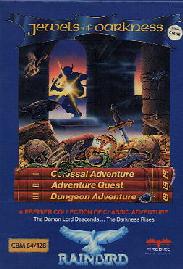 The Middle-Earth Trilogy / The Jewels of Darkness The Middle-Earth Trilogy / The Jewels of Darkness
The series was originally titled The Middle-Earth Trilogy
but was later renamed The Jewels of Darkness. According to
some reports, this was because of conflicts with the
Tolkien estate.
A compilation of these three games was released in a single
box in 1986 but the games had been available separately
before that. At least for Commodore 64 and Spectrum, these
games are available both in text versions and with
graphics. I think the original separate versions were text
only and the Jewels of Darkness versions with graphics.
At least the Amstrad version was distributed by Rainbird.
-
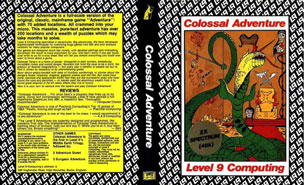 Colossal Adventure Colossal Adventure
Type: Text only/Drawn graphics
Written 1983 by Mike Austin, Nick Austin and Pete Austin.
Runs on:
Notes: This was an expanded version of the original Adventure by
Will Crowther and Don Woods. The modifications are mostly an
enlarged master endgame and a more detailed outside world. In
the early versions there was no mention of it being the first
part of a trilogy.
There seems to be a bug in the Amiga version, in the two-pit
room, making the game impossible to solve.
-
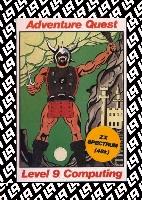 Adventure Quest Adventure Quest
Type: Text only/Drawn graphics
Written 1983 by Mike Austin, Nick Austin and Pete Austin.
Runs on:
Comments: This is mainly a collection of puzzles which don't always make
sense in the context.
Package blurb: Explore Middle Earth, finding and following the hidden paths
leading to the Dark Tower. Umpteen obstacles bar the way,
but we have faith in your skill! This massive, pure-text
adventure has over 200 locations and a wealth of puzzles.
Middle Earth has long been a tranquil and peaceful place. The
battles against the Dark Lord are ancient history, and no
dragon has been seen since the sack of Esgaroth. Even the
last elves sailed for the West centuries ago, after the
rescue of their fellows from the dungeons below Colossal
Cavern.
But disaster struck. A vast army of orcs swept down from the
north, crushing all in their path, and they now besiege the
last brave defenders in Minas Tirith. All seems hopeless.
Then, to your amazement, you are summoned by the Wizards High
Council.
"The Orcs are servants of the Demon Lord, AGLIAREPT, who has
taken up residence in the Dark Tower on the edge of the
world. From safety he controls our enemies. Perhaps one brave
hero, acting alone, could sneak into the tower and defeat
him. I don't think you've a ghost of a chance, but the King
insists we do something. Will you volunteer?"
Naturally you refuse. But no one listens. Good luck!
-
 Dungeon Adventure Dungeon Adventure
Type: Text only/Drawn graphics
Written 1984 by Mike Austin, Nick Austin and Pete Austin.
Runs on:
Comments: A strange dungeon-crawl and treasure-hunt adventure. It
introduces a magic system that was in part derived from the
one introduced in the role-playing game D & D.
 The Silicon Dreams Trilogy The Silicon Dreams Trilogy
The trilogy was released in 1986, although the games had been
available separately before that. Early advertising calls
the series "Silicon Dream" without the "s".
All the games in the series center arount Kim Kimberly,
legendary secret agent and space navigator.
At least the Amstrad version was distributed by Rainbird.
-
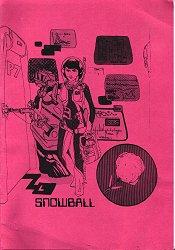 Snowball Snowball
Type: Text only/Drawn graphics
Written 1983 by Mike Austin, Nick Austin, Pete Austin and Ian Buxton [Additional expertise].
Runs on:
Notes: I don't think this was meant to be part one of a trilogy from
the start. Snowball had more than 7000 rooms, but 6800 of them
were part of a color-coded maze.
Comments: You must stop the space ship Snowball, carrying thousands of
colonists, from crashing into its destination planet Eden.
-
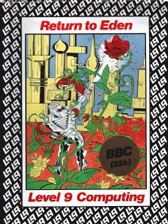 Return to Eden Return to Eden
Type: Text only/Drawn graphics
Written 1984 by Nick Austin, Chris Queen and Tim Noyce [pictures].
Runs on:
Notes: Contained about 220 locations.
Comments: After approaching Eden, you have to escape to the city of
Enoch before certain imprisonment due to false accusations.
-
The Worm in Paradise
Type: Text only/Drawn graphics
Written 1985 by Mike Austin, Nick Austin, Pete Austin and James Horsler [pictures].
Runs on:
Comments: Yet a couple of years later, Kim Kimberley has become a legend
on Eden. The player sets out to uncover the government's dark
secrets. This game features lots of political statements.
Package blurb: A science fiction adventure in 25th Century Eden, with 200+
pictures on everything but the BBC. You may never bite
another apple!
The Worm in Paradise concludes the Silicon Dream Trilogy,
following the award-winning Snowball and Return to Eden
(though you don't need to have played these). It's your last
chance to give an arm and a leg for an inflatable Kim
Kimberley.
The robot megapolis of Enoch may be a paradise for the silent
majority, but it's a real challenge for those with higher
ambitions. Especially if, with your faithful Dagget wrapped
round your leg, you intend to save the world.
The Time and Magik Trilogy
These games weren't originally planned as a trilogy, but they all
center around "magik" and magical events.
-
Lords of Time
Type: Drawn graphics/Text only
Written 1983 by Sue Gazzard and Ian Buxton [Additional expertise].
Runs on:
Notes: The first Level 9 game not designed by the Austins. It was
initially to be published as "Timelords."
Comments: Time-travelling through the distant past, you collect a number
of items to defeat the evil Lords of Time.
Package blurb: Travel through world history, seeking items to avert the evil
future planned by the Timelords. Shed light on the Dark
Ages, go romin' with Caesar's legions etc. etc. This
massive, pure-text adventure has over 200 locations and lots
of puzzles.
Into the cauldron you must throw ---
an olive branch, makes friendship grow.
A dragon's wing, a sign of flight,
An ivory tusk, a sign of might.
Mix in the teardrop, a touch of sadness,
and the evil eye, a sign of badness.
Add a dinosaur egg, a sign of birth,
with the jester's cap, a symbol of mirth,
plus the silicon chip, a vital invention,
and the golden buckle, a bone of contention.
If you do this, before time runs out,
a winner you'll be --- there is no doubt.
But take care when you find the lords,
or you'll not gain your just rewards,
your quest will all have been in vain,
and you will have to start again.
-
Red Moon
Type: Drawn graphics
Written 1985 by David Williamson [design], Simon Aspinall [implementation], Pete Austin [design and implementation] and James Horsler [pictures].
Runs on:
Comments: The Red Moon crystal has to be retrieved.
-
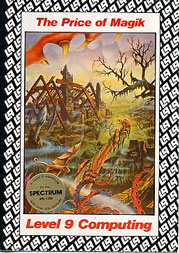 The Price of Magik The Price of Magik
Type: Drawn graphics
Written 1986 by Pete Austin [design], Nick Austin [implementation], Mike Austin [implementation], David Williamson [original idea] and James Horsler [pictures].
Runs on:
Notes: There were three different versions available for the Spectrum: A
text-only version, a graphic version with reduced text, and a
Spectrum 128K version with full text and graphics.
Package blurb: The House of the Red Moon is a weird place, haunted by arcane
powers from the mythical past. It is the only place where
one might rise from Sorcerer's Apprentice to powerful Wizard,
yet cheat the Price of Magik.
Emerald Isle
Type: Drawn graphics
Written 1984 by Shaun D. Abbott [design] and James Horsler [pictures].
Runs on:
Notes: At some point, this game was meant to be the first in the same
trilogy as Red Moon and The Price of Magik.
Comments: Stranded on an island, the protagonist finds a lost
civilisation.
Package blurb: Emerald Isle lies in the Bermuda Triangle, hidden by fogs and
treacherous waters and peopled by the remnants of a strange
civilisation. This is a massive adventure and, if you read
the gold label, you'll probably find this version has over
200 pictures!
You play the part of an aircraft pilot, employed to ferry
urgent 'documents' around the Carribean. Fierce winds seize
the 'plane over the Bermuda Triangle and hurl it to
destruction; you escape by parachute at the last moment.
As you float down towards an island below, you recognise the
coastline from an old map. It is the lonely atoll, "Emerald
Isle", which few people visit and from which none return.
It is said that only one person may leave -- the ruler of the
land -- and that each visitor is tested. Success promotes you
to King or Queen, failure promotes you to the next life.
Explore peculiar towns, meet peculiar people, learn the
peculiar purpose of the 'letters' and travel on a railway
which is simplicity itself compared to BR's peculiar fare
system. Don't be too afraid of the dark, and watch out for
the spider!
The Saga of Erik the Viking
Type: Drawn graphics
Written 1984 by Pete Austin [game design and programming] and Joan Lamb [graphics].
Runs on:
Notes: Based on the book of the same title by Terry Jones (from Monty
Python). The book was later filmed by him. The game and the
film have different stories, though.
This was distributed by Mosaic Publishing.
Package blurb: Travel, as Erik the Viking, in search of the evil Dogfighters
who have kidnapped your family. Explore authentic Viking
settlements and seek help from Wizards, Dragons and Giants in
strange lands. This exciting adventure game is fully
illustrated with colourful graphics.
For more information, see Mosaic Publishing
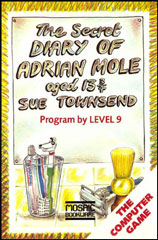 The Secret Diary of Adrian Mole aged 13 3/4 The Secret Diary of Adrian Mole aged 13 3/4
Type: Drawn graphics/Multiple choice
Written 1985 by Pete Austin [programming] and James Horsler [graphics].
Runs on:
Notes: Divided into four parts. Based on the children's book of the
same title by Sue Townsend.
This was distributed by Mosaic Publishing.
Package blurb: I learned today that I am to be the subject of a computer
game. The object of the game is to make me popular with
everyone, which sounds dead brilliant. Apparently they've
written an enormous programme containing 200 kilos of text,
which Branbox Henderson says is a lot. Now everyone else can
have a go at coping with all the problems that beset me over
an entire year of my life. It's an illustrated text game,
which means you have artistic pictures to look at while you
ponder about what to do next. So have a go, and see what
it's like being a budding intellectual and poet who has to
cope with my family, friends and the dog. Then you'll know
what I have to put up with. Ha! Ha! Ha!
For more information, see Mosaic Publishing
The Archers
Type: Graphics/Multiple choice
Written 1986 by Pete Austin and Joan Lamb [pictures].
Runs on:
Notes: Based on the British soap opera of the same name. The dialog
was scripted by the real Archers scriptwriters in
collaboration with Level 9 Computing.
This was distributed by Mosaic Publishing.
Comments: Your goal is to write scripts to keep the audience ratings for
the Archers soap opera up.
For more information, see Mosaic Publishing
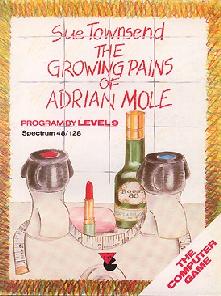 The Growing Pains of Adrian Mole The Growing Pains of Adrian Mole
Type: Drawn graphics/Multiple choice
Written 1987 by Pete Austin and Joan Lamb [pictures].
Runs on:
Notes: Based on a children's book by Sue Townsend.
This was distributed by Mosaic Publishing.
Package blurb: Welcome to the world of Adrian Mole, as seen through the
pages of his diary. The aim of the game is to make Adrian as
popular as possible with everyone. Adrian's life is a
succession of decisions which you make on his behalf, by
answering multiple choice questions. Adrian is already an
intellectual (or so he tells us), but trying to make him
popular as well is not as easy as it seems. So good luck!!!
For more information, see Mosaic Publishing
Ingrid series
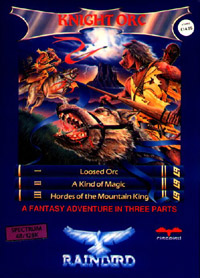 Knight Orc Knight Orc
Type: Bitmap graphics
Written 1987 by Pete Austin.
Runs on:
Notes: Divided into three parts. A lot of what happens in this game
is a send-up of British Telecom's online game MUD2.
Comments: As Grindleguts the orc, you are in an eternal battle with
annoying NPCs killing each other on and off, as you try to
discover what has happened to you. Medieval setting. In the
third part, the player is in for a surprise.
Package blurb: Knight Orc is Level 9's most innovative and fun-packed
adventure to date. Set in three parts, it casts you as an
oppressed orc in a magical world where all is not as it first
seems. For generations humans have been persecuting orcs,
and now it's time to get your own back.
Knight Orc is a challenging game which is truly interactive.
Each character leads its own life in the game, and their
actions can affect you and the outcome of the adventure.
Communications with other characters, learning spells and
solving puzzles are all a vital part of the game if you are
to escape the mystical world and take revenge on humankind.
The graphics are marvellous -- bright, detailed, and a
totally new style from that of previous adventures.
KNIGHT ORC FEATURES:
- Character Interaction: The ability to communicate with
and give commands to other characters. You will need to
co-ordinate a band of five creatures to complete your
quest.
- The characters each lead independent lives, separately
within the game, in search of their own goals.
- High level commands, e.g. move straight to a named place
or follow a named character.
- Superb quality colour illustrations.
- New improved language interpreter with multiple command
sentences and huge 1000 word vocabulary.
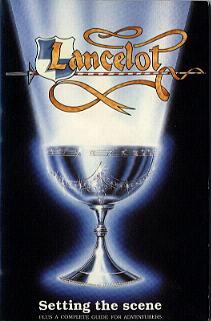 Lancelot Lancelot
Type: Bitmap graphics
Written 1988 by Christina Erskin [story and final game text], Joan Lamb [pictures], Neil Scrimgeour [pictures], Dicken Peeke [pictures], Nusarath Jahan [pictures], Mike Austin [system], Nick Austin [system], John Jones-Steele [system] and Mike Bryant [system].
Runs on:
Notes: Divided into three parts.
Comments:
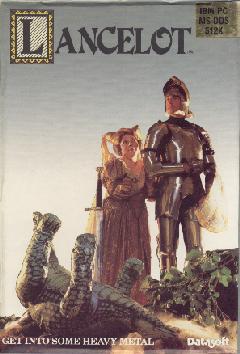 You, as the legendary Lancelot, are out on a quest
for the Holy Grail, and must, along the way, save imprisoned
knights and damsels in distress. You, as the legendary Lancelot, are out on a quest
for the Holy Grail, and must, along the way, save imprisoned
knights and damsels in distress.
 Scapeghost Scapeghost
Type: Bitmap graphics
Written 1989 by Sandra Sharkey, Pete Gerrard and Pete Austin.
Runs on:
Notes: Divided into three parts. It was originally announced as "Spook".
Comments: A police man, killed by criminals, returns from beyond the grave
as a ghost who has to overcome the troubles of ghost-dom
together with his ghost friends, in order to solve his final
case and revenge his own death.
Package blurb: It's not easy being a ghost; betrayed to a criminal gang and
falsely blamed for your own death when they escape with a
hostage.
Reincarnated in your old haunts, you have just three nights
to clear your name. But with your detective skills and new
psychic powers, a spirited revenge is a dead cert. The
gangsters haven't the ghost of a chance!
Spaceghost uses the full power of Level 9's adventure system,
with its unique "racetracks" and:
- hand-drawn pictures on disc;
- advanced English parser, including go/run to, find,
follow etc;
- true multi-person puzzles, requiring cooperation.
Here is a review of Scapeghost
|